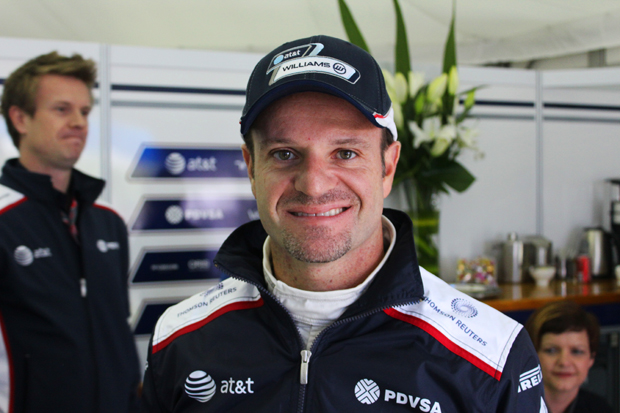Pit lane tech talk with Rubens Barrichello

After 19 seasons in Formula One racing, Brazilian driver Rubens Barrichello has seen technology change the sport he loves. From advanced simulators to video games, Barrichello opened up on how he feels about driving in the 21st century to ZDNet Australia.

Rubens Barrichello
(Credit: Luke Hopewell/ZDNet Australia)
With the raw cost of technology in Formula One racing cars now reaching hundreds of millions of dollars, Barrichello drives in a different world to the one he did when he started racing back in 1993.
Despite the level of technology in Formula One today, however, Barrichello still feels that he's driving a car, not a computer.
"You're always driving a car. There's a wrong attitude when it comes to thinking of it as a computer. The car cannot be driven by itself, you're definitely taking it around," Barrichello said.
If anything, Barrichello feels that technology has made motorsports much more competitive.
"I used to have one button on my steering wheel, which was the radio, in 1993. Now I have 26 buttons. I have to drive, change gears and keep on doing so many things while I'm driving," he said.
Barrichello added that with more technology comes more speed, putting more strain on the driver physically.
"The G forces have increased since 1993 so you need to be tougher as well."
We asked him if he feels that all this technology has taken the spirit out of racing.
"I don't see that," he said. "You could argue so many ways that races nowadays are different but at the end of the day a race is a race and it doesn't matter if you change gear with one hand or two. I believe in that," he said.
Technology is doing more than just improving current Formula One racing teams, Barrichello said, it's helping a new generation of drivers into the sport.
"[Computer] games are becoming better and better and that's [good] for racing drivers. I have two kids, aged five and nine, and [games] are becoming more popular at home ... it's crazy," he said.
Barrichello added, however, that virtual racing is still very different to getting onto a track and burning rubber for real.
"It differs a lot when you get to the [actual] driving so I'm not sure if [games are] an inspiration or not. I know in Brazil, you can see a lot of young kids motivated to drive, TV on or not," he said, joking that his kids were yet to beat him on Xbox 360.
The future of racing
Barrichello believes that the level of technology used by drivers in Formula One won't advance beyond where it is now, simply due to space limitations on the steering wheel.
"I think this is where [technology] will stop. If you look, it's just physically impossible to fit more on there," Barrichello said.
Williams' race engineer Tom McCullough had his own take on the extent of technology takeover in Formula One.
"Steering wheels are little computers to a certain degree, but mainly they're glorified keyboards with visual displays on them," he said. "I think the technology that makes them very expensive is to get them very light, very reliable and very user-friendly. From a technology point of view I don't think there's that much [in there]," he said.
McCullough said that the Williams team has developed its own training simulators that come pre-programmed with the specific build of a car and the exact model of season tracks for drivers.
Tom McCullough
(Credit: Luke Hopewell/ZDNet Australia)
McCullough said it took quite a long time to develop their simulator in-house. "It uses the same car ECU [engine control unit], models and systems the real car uses so we can generate data which correlates very well to track data," he said.
McCullough added that the simulator is used for testing how a car could run on a track during the design process and how to squeeze the most out of it once it's been built. Barrichello noted, however, that the simulator still pales in comparison to actually being on the track.
"Simulators aren't to the level where it's that similar to [driving]. They use most of my time in the factory to set up the machine and to get closer to what I think is real life," he said, adding that it is more for younger drivers to learn the tracks.
"In the case of my team-mate who's young and hasn't driven here, he did 200 laps of Albert Park [on a simulator] to learn the circuit. In those cases, it's a bit easier because, when I got to my first race, I had no idea if it was left or right, I had to go out there and learn. Now he knows the basics."
"It's not the same, but he knows the basics," Barrichello added.
Formula One tablets?
During a race, McCullough, a self-professed "non-IT person", gets race data such as driver comments and lap times fed to his clipboard by three assistants.
"In a sense I'm very lucky, because I stand in front of the car on the radio with a clipboard and have lots of input from lots of people who I can rely on and trust pretty accurately [for that] data," he said, adding, however, that the task would be sped up with the addition of the latest tablet computers like the iPad.
"A lot of that is fed into my basic print sheets and the driver comments are typed by hand so I can see voice recognition software that types the comments in [automatically] might help in future."
Some teams, McCullough said, are using tablet computers already. Williams tried using tablets several years ago with little success, he said.
"Two or three years ago, one of the engineers at Williams did use one, but that was when the hardware wasn't [up to scratch]. I think that was when we were with HP and they had some problems ... during the rain it all went wrong as well," he said.
"I think these days the technology and the hardware [in tablets] is much better. I can see us heading towards [using tablets] in the future."
McCullough's data comes from the 150 sensors on a Formula One car, measuring everything from aerodynamic performance, to speed, petrol use, tyre temperature and pressure, right down to how the engine is firing.
US-based telco AT&T follows the Williams team around the world setting up private communication networks back to the Williams headquarters in the UK during races. Using the AT&T gear, Williams engineers are able to follow along with the readings coming from the car in real time and they can make changes on the fly, something McCullough finds invaluable.
"In the old days, you used to just listen to the driver and in the evenings, sit down and look at the data. You made a few wrong decisions because between the engineer and the driver, you're not as good as all the sensors on the car. Sometimes you are, sometimes you're not. What it allows you to do is very quickly gather information and make the decisions based on that," he said.
You can see the Williams team and Barrichello in action at the Australian Formula One Grand Prix, which starts today in Melbourne and runs through to 27 March.
Luke Hopewell travelled to the Grand Prix as a guest of AT&T.